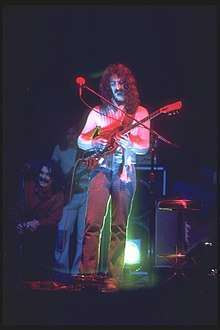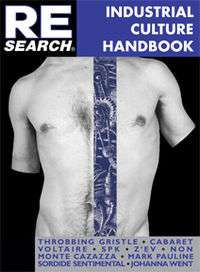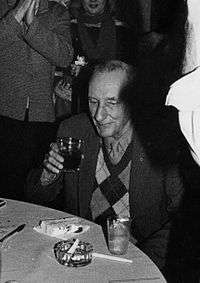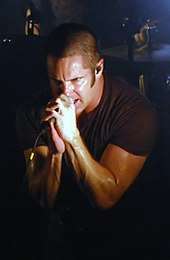Industrial music
Industrial music is a genre of music that draws on harsh, transgressive or provocative sounds and themes. AllMusic defines industrial music as the "most abrasive and aggressive fusion of rock and electronic music" that was "initially a blend of avant-garde electronics experiments (tape music, musique concrète, white noise, synthesizers, sequencers, etc.) and punk provocation".[2] The term was coined in the mid-1970s with the founding of Industrial Records by members of Throbbing Gristle and Monte Cazazza. While the genre name originated with Throbbing Gristle's emergence in the United Kingdom, concentrations of artists and labels vital to the genre also emerged in the United States, namely in Chicago.
| Industrial | |
|---|---|
| Stylistic origins | |
| Cultural origins | Early-mid-1970s United Kingdom, United States (Chicago), and Germany |
| Typical instruments |
|
| Derivative forms |
|
| Subgenres | |
| Fusion genres | |
| |
| Regional scenes | |
| |
| Other topics | |
| Electronic music |
|---|
| Experimental forms |
| Popular styles |
| Other topics |
The first industrial artists experimented with noise and aesthetically controversial topics, musically and visually, such as fascism, sexual perversion, and the occult. Prominent industrial musicians include Throbbing Gristle, Monte Cazazza, SPK, Boyd Rice, Cabaret Voltaire, and Z'EV.[3] On Throbbing Gristle's 1977 debut album The Second Annual Report, they coined the slogan "industrial music for industrial people". Chicago-based independent label Wax Trax Records featured a heavy roster of industrial music acts. The precursors that influenced the development of the genre included acts such as electronic music group Kraftwerk, experimental rock acts such as Pink Floyd and Frank Zappa, psychedelic rock artists such as Jimi Hendrix, and composers such as John Cage. Musicians also cite writers such as William S. Burroughs, and philosophers such as Friedrich Nietzsche as influences.
While the term was self-applied by a small coterie of groups and individuals associated with Industrial Records in the late 1970s, it was broadened to include artists influenced by the original movement or using an "industrial" aesthetic.[4] Over time, the genre's influence spread into and blended with styles including ambient, synth music and rock such as Front 242, Front Line Assembly, KMFDM, and Sister Machine Gun from the Chicago-based Wax Trax Records. Electro-industrial music is a primary subgenre that developed in the 1980s, with the most notable bands in the genre being Front Line Assembly and Skinny Puppy. The two other most notable hybrid genres are industrial rock and industrial metal, which include bands such as Nine Inch Nails, Ministry, and Fear Factory, the first two of which released platinum-selling albums in the 1990s.
History
Precursors

Industrial music drew from a broad range of predecessors. According to the Oxford English Dictionary, the genre was first named in 1942 when The Musical Quarterly called Dmitri Shostakovich's 1927 Symphony No. 2 "the high tide of 'industrial music'."[5] Similarly, in 1972 The New York Times described works by Ferde Grofé (especially 1935's A Symphony in Steel) as a part of "his 'industrial music' genre [that] called on such instruments as four pairs of shoes, two brooms, a locomotive bell, a pneumatric drill and a compressed-air tank".[6] Though these compositions are not directly tied to what the genre would become, they are early examples of music designed to mimic machinery noise and factory atmosphere.
In his book Interrogation Machine: Laibach and NSK, Alexei Monroe argues that Kraftwerk were particularly significant in the development of industrial music, as the "first successful artists to incorporate representations of industrial sounds into nonacademic electronic music."[7] Industrial music was created originally by using mechanical and electric machinery, and later advanced synthesizers, samplers and electronic percussion as the technology developed. Monroe also argues for Suicide as an influential contemporary of the industrial musicians.[7] Groups cited as inspirational by the founders of industrial music include The Velvet Underground, Joy Division, and Martin Denny.[8] Genesis P-Orridge of Throbbing Gristle had a cassette library including recordings by the Master Musicians of Jajouka, Kraftwerk, Charles Manson, and William S. Burroughs.[9] P-Orridge also credited 1960s rock such as The Doors, Pearls Before Swine, The Fugs, Captain Beefheart, and Frank Zappa in a 1979 interview.[10]
Chris Carter also enjoyed and found inspiration in Pink Floyd and Tangerine Dream.[11] Boyd Rice was influenced by the music of '60s girl groups and tiki culture.[12] Z'EV cited Christopher Tree (Spontaneous Sound), John Coltrane, Miles Davis, Tim Buckley, Jimi Hendrix, and Captain Beefheart, among others together with Tibetan, Balinese, Javanese, Indian, and African music as influential in his artistic life.[13] Cabaret Voltaire cited Roxy Music as their initial forerunners, as well as Kraftwerk's Trans-Europe Express.[14] Cabaret Voltaire also recorded pieces reminiscent of musique concrète and composers such as Morton Subotnick.[15] Nurse with Wound cited a long list of obscure free improvisation and Krautrock as recommended listening.[16] 23 Skidoo borrowed from Fela Kuti and Miles Davis's On the Corner.[17] Many industrial groups, including Einstürzende Neubauten, took inspiration from world music.[18]
Many of the initial industrial musicians preferred to cite artists or thinkers, rather than musicians, as their inspiration. Simon Reynolds declares that "Being a Throbbing Gristle fan was like enrolling in a university course of cultural extremism."[19] John Cage was an initial inspiration for Throbbing Gristle.[20] SPK appreciated Jean Dubuffet, Marcel Duchamp, Jean Baudrillard, Michel Foucault, Walter Benjamin, Marshall McLuhan, Friedrich Nietzsche, and Gilles Deleuze, as well as being inspired by the manifesto of the eponymous Socialist Patients' Collective.[21] Cabaret Voltaire took conceptual cues from Burroughs, J. G. Ballard, and Tristan Tzara.[22] Whitehouse and Nurse with Wound dedicated some of their work to the Marquis de Sade; the latter also took impetus from the Comte de Lautréamont.[16]
Another influence on the industrial aesthetic was Lou Reed's Metal Machine Music. Pitchfork Music cites this album as "inspiring, in part, much of the contemporary avant-garde music scene—noise, in particular."[23] The album consists entirely of guitar feedback, anticipating industrial's use of non-musical sounds. The New York Times described American avant-garde band The Residents as having "presaged forms of punk, new wave and industrial music".[24]
Industrial Records
Industrial Music for Industrial People was originally coined by Monte Cazazza[25] as the strapline for the record label Industrial Records, founded by British art-provocateurs Throbbing Gristle.[26] The first wave of this music appeared with Throbbing Gristle, from London; Cabaret Voltaire, from Sheffield;[27] and Boyd Rice (recording under the name NON), from the United States.[28] Throbbing Gristle first performed in 1976,[29] and began as the musical offshoot of the Kingston upon Hull-based COUM Transmissions.[30] COUM was initially a psychedelic rock group, but began to describe their work as performance art in order to obtain grants from the Arts Council of Great Britain.[20] COUM was composed of P-Orridge and Cosey Fanni Tutti.[20] Beginning in 1972, COUM staged several performances inspired by Fluxus and Viennese Actionism. These included various acts of sexual and physical abjection.[11] Peter Christopherson, an employee of commercial artists Hipgnosis, joined the group in 1974, with Carter joining the following year.[30]
The group renamed itself Throbbing Gristle in September 1975, their name coming from a northern English slang word for an erection.[30] The group's first public performance, in October 1976, was alongside an exhibit titled Prostitution, which included pornographic photos of Tutti as well as used tampons. Conservative politician Nicholas Fairbairn declared that "public money is being wasted here to destroy the morality of our society" and blasted the group as "wreckers of civilization."[31] The group announced their dissolution in 1981, declaring that their "mission" has been "terminated."[32]
Wax Trax! Records
Chicago record label Wax Trax! Records was prominent in the widespread attention industrial music received starting in the early 1980s. The label was started by Jim Nash and Dannie Flesher. The label's first official release was an EP in 1980 entitled Immediate Action by Strike Under. The label went on to distribute some of the most prominent names in industrial throughout the 1980s and 1990s. Wax Trax! also distributed industrial releases in the United States for the Belgium record label Play It Again Sam Records, and had opened a North American office dubbed Play It Again Sam U.S.A. as a division of Wax Trax!. Wax Trax! was subsequently purchased by TVT Records in 1992. When TVT closed its doors in 2001, Wax Trax! re-emerged under a different name, WTII Records (Wax Trax 2 Records), releasing industrial and other forms of electronic music.
Expansion of the scene
The bands Clock DVA,[33] Nocturnal Emissions,[34] Whitehouse,[35] Nurse with Wound,[36] and SPK[37] soon followed. Whitehouse intended to play "the most brutal and extreme music of all time", a style they eventually called power electronics.[32] An early collaborator with Whitehouse, Steve Stapleton, formed Nurse with Wound, who experimented with noise sculpture and sound collage.[38] Clock DVA described their goal as borrowing equally from surrealist automatism and "nervous energy sort of funk stuff, body music that flinches you and makes you move."[17] 23 Skidoo, like Clock DVA, merged industrial music with African-American dance music, but also performed a response to world music. Performing at the first WOMAD Festival in 1982, the group likened themselves to Indonesian gamelan.[39] Swedish act Leather Nun were signed to Industrial Records in 1978, being the first non-TG/Cazazza act to have an IR-release.[25] Their singles eventually received significant airplay in the United States on college radio.[40]

Across the Atlantic, similar experiments were taking place. In San Francisco, performance artist Monte Cazazza began recording noise music.[42] Boyd Rice released several albums of noise, with guitar drones and tape loops creating a cacophony of repetitive sounds.[43] In Boston, Sleep Chamber and other artists from Inner-X-Musick began experimenting with a mixture of powerful noise and early forms of EBM. In Italy, work by Maurizio Bianchi at the beginning of the 1980s also shared this aesthetic.[44] In Germany, Einstürzende Neubauten mixed metal percussion, guitars, and unconventional instruments (such as jackhammers and bones) in stage performances that often damaged the venues in which they played.[45] Blixa Bargeld, inspired by Antonin Artaud and an enthusiasm for amphetamines, also originated an art movement called Die Genialen Dilettanten.[46] Bargeld is particularly well known for his hissing scream.[46]
In January 1984, Einstürzende Neubauten performed a Concerto for Voice and Machinery at the Institute of Contemporary Arts (the same site as COUM's Prostitution exhibition), drilling through the floor and eventually sparking a riot.[47] This event received front-page news coverage in England.[47] Other groups who practiced a form of industrial "metal music" (that is, produced by the sounds of metal crashing against metal) include Test Dept,[48] Laibach,[49] and Die Krupps, as well as Z'EV and SPK.[18] Test Dept were largely inspired by Russian Futurism and toured to support the 1984-85 UK miners' strike.[50] Skinny Puppy embraced a variety of industrial forefathers and created a lurching, impalatable whole from many pieces. Swans, from New York City, also practiced a metal music aesthetic, though reliant on standard rock instrumentation.[51] Laibach, a Slovenian group who began while Yugoslavia remained a single state, were very controversial for their iconographic borrowings from Stalinist, Nazi, Titoist, Dada, and Russian Futurist imagery, conflating Yugoslav patriotism with its German authoritarian adversary.[52] Slavoj Žižek has defended Laibach, arguing that they and their associated Neue Slowenische Kunst art group practice an overidentification with the hidden perverse enjoyment undergirding authority that produces a subversive and liberatory effect.[53] In simpler language, Laibach practiced a type of agitprop that was widely utilized by industrial and punk artists on both sides of the Atlantic.
Following the breakup of Throbbing Gristle, P-Orridge and Christopherson founded Psychic TV and signed to a major label.[54] Their first album was much more accessible and melodic than the usual industrial style, and included hired work by trained musicians.[55] Later work returned to the sound collage and noise elements of earlier industrial.[56] They also borrowed from funk and disco. P-Orridge also founded Thee Temple ov Psychick Youth, a quasi-religious organization that produced video art.[57] Psychic TV's commercial aspirations were managed by Stevo of Some Bizzare Records, who released many of the later industrial musicians, including Einstürzende Neubauten, Test Dept, and Cabaret Voltaire.[58]
Cabaret Voltaire had become friends with New Order, and began to practice a similar form of danceable electropop.[59] Christopherson left Psychic TV in 1983 and formed Coil with John Balance. Coil made use of gongs and bullroarers in an attempt to conjur "Martian," "homosexual energy".[60] David Tibet, a friend of Coil's, formed Current 93; both groups were inspired by amphetamines and LSD.[61] J. G. Thirlwell, a co-producer with Coil, developed a version of black comedy in industrial music, borrowing from lounge as well as noise and film music.[62] In the early 1980s, the Chicago-based record label Wax Trax! and Canada's Nettwerk helped to expand the industrial music genre into the more accessible electro-industrial and industrial rock genres.[26]
Characteristics and history
The birth of industrial music was a response to "an age [in which] the access and control of information were becoming the primary tools of power."[63] At its birth, the genre of industrial music was different from any other music, and its use of technology and disturbing lyrics and themes to tear apart preconceptions about the necessary rules of musical form supports the suggestion that industrial music is modernist music.[63] The artists themselves made these goals explicit, even drawing connections to social changes they wished to argue for through their music.
The Industrial Records website explains that the musicians wanted to re-invent rock music, and that their uncensored records were about their relationship with the world.[64] They go on to say that they wanted their music to be an awakening for listeners so that they would begin to think for themselves and question the world around them. Industrial Records intended the term industrial to evoke the idea of music created for a new generation, with previous music being more agricultural: P-Orridge stated that "there's an irony in the word 'industrial' because there's the music industry. And then there's the joke we often used to make in interviews about churning out our records like motorcars —that sense of industrial. And ... up till then the music had been kind of based on the blues and slavery, and we thought it was time to update it to at least Victorian times—you know, the Industrial Revolution".[65]

Early industrial music often featured tape editing, stark percussion and loops distorted to the point where they had degraded to harsh noise, such as the work of early industrial group Cabaret Voltaire, which journalist Simon Reynolds described as characterized by "hissing high hats and squelchy snares of rhythm-generator."[66] Carter of Throbbing Gristle invented a device named the "Gristle-izer", played by Christopherson, which comprised a one-octave keyboard and a number of cassette machines triggering various pre-recorded sounds.[67]
Traditional instruments were often played in nontraditional or highly modified ways. Reynolds described the Cabaret Voltaire members' individual contributions as "[Chris] Watson's smears of synth slime; [Stephen] Mallinder's dankly pulsing bass; and [Richard H.] Kirk's spikes of shattered-glass guitar."[66] Watson custom-built a fuzzbox for Kirk's guitar, producing a unique timbre.[68] Carter built speakers, effects units, and synthesizer modules, as well as modifying more conventional rock instrumentation, for Throbbing Gristle.[11] Tutti played guitar with a slide in order to produce glissandi, or pounded the strings as if it were a percussion instrument.[69] Throbbing Gristle also played at very high volume and produced ultra-high and sub-bass frequencies in an attempt to produce physical effects, naming this approach as "metabolic music."[70]
Vocals were sporadic, and were as likely to be bubblegum pop as they were to be abrasive polemics. Cabaret Voltaire's Stephen Mallinder's vocals were electronically treated.[71]
The purpose of industrial music initially was to serve as a commentary on modern society by eschewing what artists saw as trite connections to the past.[64] Throbbing Gristle opposed the elements of traditional rock music remaining in the punk rock scene, declaring industrial to be "anti-music."[69] Early industrial performances often involved taboo-breaking, provocative elements, such as mutilation, sado-masochistic elements and totalitarian imagery or symbolism, as well as forms of audience abuse,[72] such as Throbbing Gristle's aiming high powered lights at the audience.[73]
Industrial groups typically focus on transgressive subject matter. In his introduction for the Industrial Culture Handbook (1983), Jon Savage considered some hallmarks of industrial music to be organizational autonomy, shock tactics, and the use of synthesizers and "anti-music."[72] Furthermore, an interest in the investigation of "cults, wars, psychological techniques of persuasion, unusual murders (especially by children and psychopaths), forensic pathology, venereology, concentration camp behavior, the history of uniforms and insignia" and Aleister Crowley's magick was present in Throbbing Gristle's work,[74] as well as in other industrial pioneers. Burroughs's recordings and writings were particularly influential on the scene, particularly his interest in the cut-up technique and noise as a method of disrupting societal control.[75] Many of the first industrial musicians were interested in, though not necessarily sympathetic with, fascism.[76] Throbbing Gristle's logo was based on the lightning symbol of the British Union of Fascists,[77] while the Industrial Records logo was a photo of Auschwitz.[78]

Expansion and offshoots (late 1980s and early 1990s)
As some of the originating bands drifted away from the genre in the 1980s, industrial music expanded to include bands influenced by new wave music, hip hop music, jazz, disco, reggae, and new age music, sometimes incorporating pop music songwriting.[79] A number of additional styles developed from the already eclectic base of industrial music. These offshoots include fusions with noise music, ambient music, folk music, post-punk and electronic dance music, as well as other mutations and developments. The scene has spread worldwide, and is particularly well represented in North America, Europe, and Japan. Substyles inspired by industrial music include dark ambient, power electronics, Japanoise, neofolk, electro-industrial, electronic body music, industrial hip hop, industrial rock, industrial metal, industrial pop, martial industrial, power noise, and witch house.
Mainstream success (1990s and 2000s)


In the 1990s, industrial music broke into the mainstream. The genre, previously ignored or criticized by music journalists, grew popular with disaffected middle-class youth in suburban and rural areas. By this time, the genre had become broad enough that journalist James Greer called it "the kind of meaningless catch-all term that new wave once was".[80] In December 1992, Nine Inch Nails' EP Broken was certified platinum by the Recording Industry Association of America (RIAA).[81] Nine Inch Nails gained further popularity with the release of their 1994 album The Downward Spiral. The album sold almost 119,000 units in its first week of being released.[82] The Downward Spiral was certified 4x platinum by the RIAA in 1998.[83] Nine inch Nails' remix album Further Down the Spiral, released in May 1995, was certified gold by the RIAA in June 1996.[84] Nine Inch Nails' 1999 album The Fragile went to number 1 on the Billboard 200 on October 9, 1999[85] and also was certified 2x platinum in January 2000.[86] With the success of Nine Inch Nails, the band's debut album Pretty Hate Machine was certified 2x platinum by the RIAA in September 1995 and also was later certified 3x platinum by the RIAA in May 2003.[87] In the 1990s, four Nine Inch Nails songs went on the Billboard Hot 100.[88] Several industrial rock and industrial metal artists such as KMFDM, Fear Factory, Gravity Kills and Sister Machine Gun appeared on the 1995 Mortal Kombat: Original Motion Picture Soundtrack.[89] The soundtrack was certified platinum by the RIAA in January 1996.[90]
.jpg)

Marilyn Manson released its album Antichrist Superstar in 1996. Antichrist Superstar sold 132,000 in its first week of being released.[91] Antichrist Superstar was certified platinum by the RIAA two months after its release date.[92] In the United States, Antichrist Superstar sold at least 1,900,000 units.[93] Marilyn Manson's EP Smells Like Children was certified platinum in May 1998.[94] Marilyn Manson's album Mechanical Animals went to number 1, selling 223,000 copies in its first week in stores, knocking The Miseducation of Lauryn Hill by Lauryn Hill off of the top spot.[95] Mechanical Animals was certified platinum by the RIAA in February 1999[96] and sold at least 1,409,000 copies in the United States.[97] Orgy also experienced mainstream success during the 1990s. The band's 1998 album Candyass was certified platinum by the RIAA in July 1999.[98] Orgy's cover of New Order's song "Blue Monday" went to number 56 on the Billboard Hot 100[99] and number 2 on the Dance Club Songs chart.[100] White Zombie experimented with industrial metal on its 1995 album Astro-Creep 2000,[101] which was certified 2x platinum by the RIAA in March 1996.[102] White Zombie's vocalist Rob Zombie began creating pure industrial metal albums in his solo career. Rob Zombie's solo debut studio album Hellbilly Deluxe was certified 3x platinum by the RIAA less than two years after its release date.[103] In November 1999, Powerman 5000's album Tonight the Stars Revolt! was certified platinum by the RIAA.[104] The album sold at least 1,316,172 units in the United States.[105] Although the popularity of industrial music overall declined in the 2000s, both Nine Inch Nails and Marilyn Manson continued to be popular during the 2000s. Nine Inch Nails' 2005 album With Teeth went to number 1 on the Billboard 200,[85] selling 272,000 copies in its first week of being released.[106] As of October 2007, With Teeth has sold 1,100,000 copies in the United States.[107] During the 2000s, four Nine Inch Nails were on the Billboard Hot 100, including the Nine Inch Nails song "The Hand That Feeds", which went to the top 40 of the Billboard Hot 100, going to number 31 on the chart.[88] Marilyn Manson's 2003 album The Golden Age of Grotesque went to number 1 on the Billboard 200,[108] selling 118,000 copies in its first week of being released.[109]
See also
Footnotes
- Fisher, Mark (2010). "You Remind Me of Gold: Dialogue with Simon Reynolds". Kaleidoscope (9).
- "Industrial". Allmusic. All Media Network. Retrieved May 5, 2017.
- V.Vale. Re/Search #6/7: Industrial Culture Handbook, 1983.
- "... journalists now use 'industrial' as a term like they would 'blues.'"—Genesis P-Orridge, RE/Search #6/7, p. 16.
- "Industrial". Oxford English Dictionary (3rd ed.). Oxford University Press. September 2005. (Subscription or UK public library membership required.)
- Henahan, Donal (April 4, 1972). "Limned the Landscape". The New York Times: 46. Retrieved November 17, 2018.
- Monroe, p. 212
- RE/Search #6/7, p. 11–12.
- RE/Search #6/7, p. 19.
- Reynolds 2005, p. 225.
- Reynolds 2005, p. 227.
- RE/Search #6/7, p. 67.
- RE/Search #6/7, p. 117
- Reynolds 2005, pp. 154, 159.
- Reynolds 2005, p. 156.
- Reynolds 2005, p. 242.
- Reynolds 2005, p. 243.
- Reynolds 2005, p. 485.
- Reynolds, Simon (April 7, 2009). "Sonic Youth are caught under the influence". The Guardian. Guardian News and Media Limited. Retrieved October 28, 2009.
- Reynolds 2005, p. 226.
- RE/Search #6/7, p. 97–105.
- Reynolds 2005, pp. 154–155, 171.
- Petrusich, Amanda (September 17, 2007). "Interviews: Lou Reed". Retrieved April 16, 2010.
- Slotnik, Daniel E. (November 3, 2018). "Hardy Fox, of the Avant-Garde Band the Residents (Maybe), Dies at 73". New York Times. Retrieved April 27, 2020.
- "Industrial Records". Brainwashed. Retrieved October 28, 2009.
- Kilpatrick, Nancy. The Goth Bible: A Compendium for the Darkly Inclined. New York: St. Martin's Griffin, 2004, ISBN 0-312-30696-2, p. 86.
- RE/Search #6/7, p. 42–49.
- RE/Search #6/7, p. 50–67.
- Reynolds 2005, p. 224.
- RE/Search #6/7, p. 17.
- Reynolds 2005, p. 229.
- Reynolds 2005, p. 240.
- Ankeny, Jason. "Clock DVA Biography". Allmusic. Rovi Corporation. Retrieved October 28, 2009.
- Torreano, Bradley. "Nocturnal Emissions Biography". Allmusic. Rovi Corporation. Retrieved October 28, 2009.
- Schaefer, Peter. "Whitehouse Biography". Allmusic. Rovi Corporation. Retrieved October 28, 2009.
- Reynolds 2005, p. 241.
- RE/Search #6/7, pp. 92–105.
- Reynolds 2005, pp. 241–242.
- Reynolds 2005, pp. 243–244.
- Sutton, Michael. "Leather Nun Biography". Allmusic. Rovi Corporation. Retrieved October 28, 2009.
- RE/Search #6/7, p. 2.
- RE/Search #6/7, pp. 68–81.
- RE/Search #6/7, pp. 50–67.
- Torreano, Bradley. "Maurizio Bianchi Biography". Allmusic. Rovi Corporation. Retrieved October 28, 2009.
- Huey, Steve. "Einstürzende Neubauten Biography". Allmusic. Rovi Corporation. Retrieved October 28, 2009.
- Reynolds 2005, p. 484.
- Reynolds 2005, p. 486.
- Bush, John. "Test Dept. Biography". Allmusic. Rovi Corporation. Retrieved October 27, 2009.
- Monroe, p. 222.
- Reynolds 2005, p. 489.
- Reynolds 2005, p. 487.
- Monroe, p. 96.
- Slavoj Žižek, "Why Are Laibach and NSK Not Fascists?," M'ARS 3–4, 1993, pp. 3–4.
- Reynolds 2005, p. 474.
- Reynolds 2005, pp. 474–475.
- Reynolds 2005, pp. 480–481.
- Reynolds 2005, p. 476.
- Reynolds 2005, p. 477.
- Reynolds 2005, p. 478.
- Reynolds 2005, pp. 481–482.
- Reynolds 2005, p. 482.
- Reynolds 2005, p. 483.
- The Secret History of Rock: The Most Influential Bands You've Never Heard by Roni Sarig
- "Industrial Records: Industrial Music for Industrial People". Brainwashed Inc. Retrieved April 16, 2010.
- RE/Search #6/7, pp. 9–10.
- Reynolds 2005, p. 168.
- Reynolds 2005, p. 228.
- Reynolds 2005, pp. 169–170.
- Reynolds 2005, p. 230.
- Reynolds 2005, p. 235.
- Reynolds 2005, p. 170.
- RE/Search #6/7, p. 5.
- Ford, 8.10
- RE/Search #6/7, p. 9.
- "These ideas contributed some of the theoretical mise-en-scène for emergent Industrial groups such as Throbbing Gristle, SPK, and Cabaret Voltaire, all of whom experimented with cut-up sound and re-contextualised ambient recordings." Sargeant, Jack, "The Primer: William S. Burroughs," The Wire 300, February 2009, p. 38.
- RE/Search #6/7, p. 105
- Webb, Peter (2007). "Neo-Folk or Postindustrial Music". Exploring the Networked Worlds of Popular Music. Psychology Press. p. 80. ISBN 978-0-415-95658-1. Retrieved January 30, 2011.
- Thompson, Dave (2000). "Industrial Records". Alternative Rock. Hal Leonard Corporation. p. 780. ISBN 978-0-87930-607-6. Retrieved January 30, 2011.
- Woods, Karen (March 1992). "Industrial Index". Spin. Vol. 7 no. 12. p. 43.
- Greer, Jim (March 1992). "Nine Inches of Love". Spin. Vol. 7 no. 12. pp. 36–43.
- "American album certifications – Nine Inch Nails – Broken". Recording Industry Association of America. If necessary, click Advanced, then click Format, then select Album, then click SEARCH.
- Mayfield, Geoff (March 26, 1994). "Between the Bullets: Warming Up". Billboard. Vol. 106 no. 13. p. 135. ISSN 0006-2510. Retrieved April 8, 2018.
- "American album certifications – Nine Inch Nails – The Downward Spiral". Recording Industry Association of America. If necessary, click Advanced, then click Format, then select Album, then click SEARCH.
- "American album certifications – Nine Inch Nails – Further Down the Spiral". Recording Industry Association of America. If necessary, click Advanced, then click Format, then select Album, then click SEARCH.
- "Nine Inch Nails Chart History (Billboard 200)". Billboard. Retrieved April 8, 2018.
- "American album certifications – Nine Inch Nails – The Fragile". Recording Industry Association of America. If necessary, click Advanced, then click Format, then select Album, then click SEARCH.
- "American album certifications – Nine Inch Nails – Pretty Hate Machine". Recording Industry Association of America. If necessary, click Advanced, then click Format, then select Album, then click SEARCH.
- "Nine Inch Nails - Chart history (Hot 100)". Billboard. Retrieved May 2, 2017.
- "Mortal Kombat [Original Soundtrack] - Original Soundtrack". AllMusic. Retrieved May 19, 2017.
- "American album certifications – Soundtrack – Mortal Kombat". Recording Industry Association of America. If necessary, click Advanced, then click Format, then select Album, then click SEARCH.
- Dansby, Andrew (May 21, 2003). "Manson Golden at Number One". Rolling Stone. Retrieved April 8, 2018.
- "American album certifications – Marilyn Manson – Antichrist Superstar". Recording Industry Association of America. If necessary, click Advanced, then click Format, then select Album, then click SEARCH.
- Paine, Andre (November 8, 2010). "Marilyn Manson Plots 2011 Comeback with Indie Label". Billboard. Retrieved May 3, 2017.
- "American album certifications – Marilyn Manson – Smells Like Children". Recording Industry Association of America. If necessary, click Advanced, then click Format, then select Album, then click SEARCH.
- Boehlert, Eric (September 24, 1998). "Marilyn Manson Shows He's Dope". Rolling Stone. Retrieved May 2, 2017.
- "American album certifications – Marilyn Manson – Mechanical Animals". Recording Industry Association of America. If necessary, click Advanced, then click Format, then select Album, then click SEARCH.
- Grein, Paul (November 3, 2010). "Chart Watch Extra: Swift Joins An Elite Club". Yahoo! Music. Archived from the original on November 7, 2010. Retrieved May 3, 2017.
- "American album certifications – Orgy – Candyass". Recording Industry Association of America. If necessary, click Advanced, then click Format, then select Album, then click SEARCH.
- "Orgy - Chart history". Billboard. Retrieved May 3, 2017.
- "Orgy - Chart history (Dance Club Songs)". Billboard. Retrieved May 3, 2017.
- Erlewine, Stephen Thomas. "Astro-Creep: 2000 - Songs of Love, Destruction and Other Synthetic Delusions of the Electric Head - White Zombie". AllMusic. Retrieved May 3, 2017.
- "American album certifications – White Zombie – Astro-Creep: 2000". Recording Industry Association of America. If necessary, click Advanced, then click Format, then select Album, then click SEARCH.
- "American album certifications – Rob Zombie – Hellbilly Deluxe". Recording Industry Association of America. If necessary, click Advanced, then click Format, then select Album, then click SEARCH.
- "American album certifications – Powerman 5000 – Tonight the Stars Revolt!". Recording Industry Association of America. If necessary, click Advanced, then click Format, then select Album, then click SEARCH.
- "Powerman 5000: Is The End Near?". Blabbermouth.net. November 6, 2003. Retrieved May 6, 2017.
- Whitmire, Margo (May 11, 2005). "NIN's 'Teeth' Sparkle At No. 1". Billboard. Retrieved April 8, 2018.
- Caulfield, Keith (October 5, 2007). "Ask Billboard: Stabbing Vastly with My Nine Inch Nails". Billboard. Retrieved April 8, 2018.
- "Marilyn Manson Chart History (Billboard 200)". Billboard. Retrieved April 8, 2018.
- "Marilyn Manson Posts 'Grotesque' After No. 1". Billboard. May 21, 2003. Retrieved April 8, 2018.
References
- Ford, Simon (1999). Wreckers of Civilization. London: Black Dog Publishing. ISBN 1-901033-60-0. OCLC 473269351.CS1 maint: ref=harv (link)
- Monroe, Alexei (2005). Interrogation Machine: Laibach and NSK. Cambridge: The MIT Press. ISBN 0-262-63315-9. OCLC 1150047415 – via the Internet Archive.
- Hanley, Jason J. (Spring 2004). "'The Land of Rape and Honey': The Use of World War II Propaganda in the Music Videos of Ministry and Laibach". American Music. 22: 158–75. doi:10.2307/3592974. JSTOR 3592974.
- Reed, S. Alexander (2013). Assimilate: A Critical History of Industrial Music. New York: Oxford University Press. ISBN 9780199832606. OCLC 1147729910 – via the Internet Archive.CS1 maint: ref=harv (link)
- Reynolds, Simon (2005). Rip It Up and Start Again: Postpunk 1978–1984. London: Faber and Faber. ISBN 0571215696. OCLC 1036851652 – via the Internet Archive.CS1 maint: ref=harv (link)
- Vale, V.; Juno, Andrea, eds. (1983). Re/Search #6/7: Industrial Culture Handbook. San Francisco, CA: RE/Search Publications. ISBN 0-940642-07-7 – via the Internet Archive.